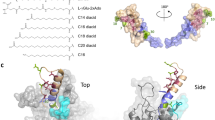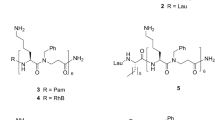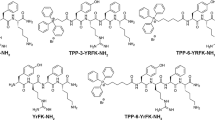Abstract
Purpose
The anorectic effect of PYY3–36 makes it a potential pharmacological weight loss treatment. Modifications of the endogenous peptide to obtain commercially attractive pharmacological and biophysical stability properties are examined.
Methods
Half-life extended PYY3–36 analogues were prepared and examined regarding Y2-receptor potency as well as biophysical and stability properties.
Results
Deamidation of asparagine in position 18 and 29 was observed upon incubation at 37°C. Asparagine in position 18 – but not position 29 – could be substituted to glutamine without detrimental effects on Y2-receptor potency. Covalent dimers were formed via the phenol impurity benzoquinone reacting with two N-terminal residues (Isoleucine-Lysine). Both residues had to be modified to suppress dimerization, which could be done without negatively affecting Y2-receptor potency or other stability/biophysical properties. Introduction of half-life extending modifications in position 30 and 35 eliminated aggregation at 37°C without negatively affecting other stability properties. Placement of a protracting moiety (fatty acid) in the receptor-binding C-terminal region reduced Y2-receptor potency substantially, whereas only minor effects of protractor position were observed on structural, biophysical or stability properties. Lipidated PYY3–36 analogues formed oligomers of various sizes depending on primary structure and solution conditions.
Conclusions
By rational design, a chemically and physically stable Y2-receptor selective, half-life extended PYY3–36 peptide has been developed.








Similar content being viewed by others
Abbreviations
- 2D-LC-MS:
-
2D liquid chromatography mass spectroscopy
- 3-Mba:
-
3-methylbutanoic acid
- Ado:
-
8-amino-3,6-dioxaoctanoic acid
- AUC:
-
Analytical ultracentrifugation
- Bis-AgGPSA:
-
Bis-aminodietoxyacetyl gamma glutamate palmitic sulphonic acid
- CD:
-
Circular dichroism
- DLS:
-
Dynamic light scattering
- HMWP:
-
High molecular weight protein
- HPLC:
-
High performance liquid chromatography
- NmeArg:
-
N-methyl-arginine
- Ph Eur:
-
European Pharmacopoeia
- PYY:
-
Peptide YY
- SEC:
-
Size exclusion chromatography
- SLS:
-
Static light scattering
- ThT:
-
Thioflavin T
- UPLC:
-
Ultra-performance liquid chromatography
- USP:
-
United States Pharmacopoeia
References
Manning S, Batterham RL. The role of gut hormone peptide YY in energy and glucose homeostasis: twelve years on. Annu Rev Physiol. 2014;76(1):585–608.
Neary MT, Batterham RL. Gut hormones: implications for the treatment of obesity. Pharmacol Ther. 2009;124(1):44–56.
Karra E, Batterham RL. The role of gut hormones in the regulation of body weight and energy homeostasis. Mol Cell Endocrinol. 2010;316(2):120–8.
Batterham RL, Cowley MA, Small CJ, Herzog H, Cohen MA, Dakin CL, et al. Gut hormone PYY3-36 physiologically inhibits food intake. Nature. 2002;418(6898):650–4.
Habib AM, Richards P, Rogers GJ, Reimann F, Gribble FM. Co-localisation and secretion of glucagon-like peptide 1 and peptide YY from primary cultured human L cells. Diabetologia. 2013;56(6):1413–6.
Batterham RL, Cohen MA, Ellis SM, Le Roux CW, Withers DJ, Frost GS, et al. Inhibition of food intake in obese subjects by peptide YY3-36. N Engl J Med. 2003;349(10):941–8.
Neary NM, Small CJ, Druce MR, Park AJ, Ellis SM, Semjonous NM, et al. Peptide YY3-36 and glucagon-like Peptide-17-36 inhibit food intake additively. Endocrinology. 2005;146(12):5120–7.
Holst JJ. Enteroendocrine secretion of gut hormones in diabetes, obesity and after bariatric surgery. Curr Opin Pharmacol. 2013;13(6):983–8.
Troke RC, Tan TM, Bloom SR. The future role of gut hormones in the treatment of obesity. Therapeutic Advances in Chronic Disease. 2013;5(1):4–14.
De Silva A, Bloom SR. Gut hormones and appetite control: a focus on PYY and GLP-1 as therapeutic targets in obesity. Gut and Liver. 2012;6(1):10–20.
Lafferty RA, Flatt PR, Irwin N. Emerging therapeutic potential for peptide YY for obesity-diabetes. Peptides. 2018;100:269–74.
Nygaard R, Nielbo S, Schwartz TW, Poulsen FM. The PP-fold solution structure of human polypeptide YY and human PYY3-36 as determined by NMR. Biochemistry. 2006;45(27):8350–7.
Cabrele C, Langer M, Bader R, Wieland HA, Doods HN, Zerbe O, et al. The first selective agonist for the neuropeptide YY5 receptor increases food intake in rats. J Biol Chem. 2000;275(46):36043–8.
Lecklin A, Lundell I, Salmela S, Mannisto PT, Beck-Sickinger AG, Larhammar D. Agonists for neuropeptide Y receptors Y1 and Y5 stimulate different phases of feeding in Guinea pigs. Br J Pharmacol. 2003;139(8):1433–40.
Medeiros MD, Turner AJ. Processing and metabolism of peptide-YY: pivotal roles of dipeptidylpeptidase-IV, aminopeptidase-P, and endopeptidase-24.11. Endocrinology. 1994;134(5):2088–94.
Ballantyne GH. Peptide YY(1-36) and peptide YY(3-36): part I. distribution, release and actions. Obes Surg. 2006;16(5):651–8.
Toräng S, Bojsen-Møller KN, Svane MS, Hartmann B, Rosenkilde MM, Madsbad S, et al. In vivo and in vitro degradation of peptide YY3–36 to inactive peptide YY3–34 in humans. Am J Phys Regul Integr Comp Phys. 2016;310(9):R866–74.
Olsen J, Kofoed J, Østergaard S, Wulff BS, Nielsen FS, Jorgensen R. Metabolism of peptide YY 3–36 in Göttingen mini-pig and rhesus monkey. Peptides. 2016;78:59–67.
Di L. Strategic approaches to optimizing peptide ADME properties. AAPS J. 2015;17(1):134–43.
Østergaard S, Kofoed J, Paulsson JF, Madsen KG, Jorgensen R, Wulff BS. Design of Y2 receptor selective and Proteolytically stable PYY3–36 analogues. J Med Chem. 2018;61(23):10519–30.
Huanbo T, Wencheng S, Wenyu Z, Pengju W, Michael S, Peijian Z. Recent advances in half-life extension strategies for therapeutic peptides and proteins. Curr Pharm Des. 2018;24(41):4932–46.
Bailon P, Won C-Y. PEG-modified biopharmaceuticals. Expert Opinion on Drug Delivery. 2009;6(1):1–16.
Podust VN, Balan S, Sim BC, Coyle MP, Ernst U, Peters RT, et al. Extension of in vivo half-life of biologically active molecules by XTEN protein polymers. J Control Release. 2016;240:52–66.
Havelund S, Plum A, Ribel U, Jonassen I. Lund a, Markussen J, Kurtzhals P. the mechanism of protraction of insulin Detemir, a long-acting, Acylated analog of human insulin. Pharm Res. 2004;21(8):1498–504.
Lau J, Bloch P, Schaffer L, Pettersson I, Spetzler J, Kofoed J, et al. Discovery of the once-weekly glucagon-like Peptide-1 (GLP-1) analogue Semaglutide. J Med Chem. 2015;58(18):7370–80.
Hutchinson JA, Burholt S, Hamley IW, Lundback A-K, Uddin S, Gomes dos Santos A, Reza M, Seitsonen J, Ruokolainen J. The Effect of Lipidation on the Self-Assembly of the Gut-Derived Peptide Hormone PYY3–36. Bioconjugate Chemistry. 2018;29:12.
Castelletto V, Hamley IW, Seitsonen J, Ruokolainen J, Harris G, Bellmann-Sickert K, Beck-Sickinger AG. Conformation and Aggregation of Selectively PEGylated and Lipidated Gastric Peptide Hormone Human PYY3–36. Biomacromolecules. 2018;19:12.
Bellmann-Sickert K, Elling CE, Madsen AN, Little PB, Lundgren K, Gerlach L-O, et al. Long-acting Lipidated analogue of human pancreatic polypeptide is slowly released into circulation. J Med Chem. 2011;54(8):2658–67.
Rangwala SM, D’Aquino K, Zhang Y-M, Bader L, Edwards W, Zheng S, et al. A long-acting PYY3–36 analog mediates robust anorectic efficacy with minimal Emesis in nonhuman primates. Cell Metab. 2019;29(4):837–43.
Wang W. Instability, stabilization, and formulation of liquid protein pharmaceuticals. Int J Pharm. 1999;185(2):129–88.
Geiger T, Clarke S. Deamidation, isomerization, and racemization at asparaginyl and aspartyl residues in peptides. Succinimide-linked reactions that contribute to protein degradation. J Biol Chem. 1987;262(2):785–94.
Yang H, Zubarev RA. Mass spectrometric analysis of asparagine deamidation and aspartate isomerization in polypeptides. Electrophoresis. 2010;31(11):1764–72.
Roberts CJ. Protein aggregation and its impact on product quality. Curr Opin Biotechnol 2014;30(0):211–217.
Lapidus LJ. Understanding protein aggregation from the view of monomer dynamics. Mol BioSyst. 2013;9(1):29–35.
Mahler HC, Friess W, Grauschopf U, Kiese S. Protein aggregation: pathways, induction factors and analysis. J Pharm Sci. 2009;98(9):2909–34.
Wang W, Singh SK, Li N, Toler MR, King KR, Nema S. Immunogenicity of protein aggregates - concerns and realities. Int J Pharm. 2012;431(1–2):1–11.
Rosenberg A. Effects of protein aggregates: an immunologic perspective. AAPS J. 2006;8(3):E501–7.
Kuipers BJH, Gruppen H. Prediction of molar extinction coefficients of proteins and peptides using UV absorption of the constituent amino acids at 214 nm to enable quantitative reverse phase high-performance liquid chromatography−mass spectrometry analysis. J Agric Food Chem. 2007;55(14):5445–51.
Wei Y, Thyparambil AA, Latour RA. Protein helical structure determination using CD spectroscopy for solutions with strong background absorbance from 190 to 230nm. Biochim Biophys Acta. 2014;1844(12):2331–7.
Schlein M. Insulin formulation characterization—the Thioflavin T assays. AAPS J. 2017;19(2):397–408.
Hjorth CF, Norrman M, Wahlund P-O, Benie AJ, Petersen BO, Jessen CM, et al. Structure, aggregation, and activity of a covalent insulin dimer formed during storage of neutral formulation of human insulin. J Pharm Sci. 2016;105(4):1376–86.
Cleland JL, Powell MF, Shire SJ. The development of stable protein formulations: a close look at protein aggregation, deamidation, and oxidation. Crit Rev Ther Drug Carrier Syst. 1993;10(4):307–77.
Xu B, Fallmar H, Boukharta L, Pruner J, Lundell I, Mohell N, et al. Mutagenesis and computational modeling of human G-protein-coupled receptor Y2 for neuropeptide Y and peptide YY. Biochemistry. 2013;52(45):7987–98.
Xu B, Vasile S, Ostergaard S, Paulsson JF, Pruner J, Aqvist J, et al. Elucidation of the binding mode of the Carboxyterminal region of peptide YY to the human Y2 receptor. Mol Pharmacol. 2018;93(4):323–34.
Kaiser A, Muller P, Zellmann T, Scheidt HA, Meier R, Meiler J, et al. Hydrophobic contacts specifically contribute to peptide binding at the neuropeptide Y2 receptor. Neuropeptides. 2016;55:16.
Kaiser A, Müller P, Zellmann T, Scheidt HA, Thomas L, Bosse M, et al. Unwinding of the C-terminal residues of neuropeptide Y is critical for Y2 receptor binding and activation. Angew Chem Int Ed. 2015;54(25):7446–9.
Pierpoint WS. O-Quinones formed in plant extracts. Their reactions with amino acids and peptides. Biochem J. 1969;112(5):609–16.
Yang J, Saggiomo V, Velders A, Stuart M, Kamperman M. Reaction pathways in catechol/primary amine mixtures: a window on crosslinking chemistry. PLoS One. 2016;11:e0166490.
Robinson NE, Robinson AB. Molecular clocks. Proc Natl Acad Sci. 2001;98(3):944–9.
Bech EM, Kaiser A, Bellmann-Sickert K, Nielsen SSR, Sørensen KK, Elster L, et al. Half-life extending modifications of peptide YY3–36 direct receptor-mediated internalization. Mol Pharm. 2019;16(8):3665–77.
Wang Y, Lomakin A, Kanai S, Alex R, Benedek GB. Transformation of oligomers of Lipidated peptide induced by change in pH. Mol Pharm. 2015;12(2):411–9.
Philo JS, Sydor W, Arakawa T. The glucagon-like peptide 2 analog Teduglutide reversibly associates to form Pentamers. J Pharm Sci. 2020;109(1):775–84.
Jonassen I, Havelund S, Hoeg-Jensen T, Steensgaard D, Wahlund PO, Ribel U. Design of the Novel Protraction Mechanism of insulin Degludec, an ultra-long-acting basal insulin. Pharm Res. 2012;29(8):2104–14.
Author information
Authors and Affiliations
Corresponding author
Additional information
Publisher’s Note
Springer Nature remains neutral with regard to jurisdictional claims in published maps and institutional affiliations.
Rights and permissions
About this article
Cite this article
Poulsen, C., Pedersen, M.Ø., Wahlund, PO. et al. Rational Development of Stable PYY3–36 Peptide Y2 Receptor Agonists. Pharm Res 38, 1369–1385 (2021). https://doi.org/10.1007/s11095-021-03077-x
Received:
Accepted:
Published:
Issue Date:
DOI: https://doi.org/10.1007/s11095-021-03077-x




